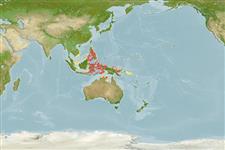Klassifizierung / Names
Namen | Synonyme | Catalog of Fishes (gen., sp.) | ITIS | CoL | WoRMS | Cloffa
Actinopterygii (Strahlenflosser) >
Ophidiiformes (Cusk eels) >
Bythitidae (Viviparous brotulas) > Brosmophycinae
Etymology: Ungusurculus: Name from Latin words 'ungulus' (= claw) and 'surculus' (= grapevine tendril), refers to the functional analogy with the pseudoclaspers and the specific shape of the inner pseudoclasper.; philippinensis: Named for the Philippine Islands, its area of distribution.. More on author: Schwarzhans.
Lebensraum / Klimazone / Range
Ökologie
; seewasser riff-verbunden; tiefenbereich 5 - 10 m (Ref. 90102). Tropical, preferred ?
Western Pacific: Philippines.
Size / Gewicht / Alter
Maturity: Lm ? range ? - ? cm
Max length : 4.8 cm SL Männchen/unbestimmt; (Ref. 76869); 5.2 cm SL (female)
Kurzbeschreibung
Morphologie | Morphometrie
Rückenflossenweichstrahlen (insgesamt): 78-87; Afterflossenweichstrahlen: 54 - 66; Wirbelzahl: 42 - 44. This species is distinct with the following characters: D 78-87, A 54-66, D/A 22-27, V in D 2.2-2.4; vertebrae 12-13+29-32=42-44; anterior nostril located 1/4 the distance from upper lip to aggregate distance to anterior margin of eye; free pseudoclaspers 2 pairs, outer pseudoclasper wing-shaped with broad base and distally slightly widened supporter without anterior hook, the inner one moderately long, with widened base, distally with 2 inward directed strong spines; cheeks with 5-6 scale rows on upper part and 3-4 rows on lower; no upper preopercular pore; otolith moderately elongate, its length to height is 2.0-2.1, pointed anterior and posterior tips, short sulcus with ventral indentation at joining of ostium and cauda, partly fused colliculi, its centre anterior to centre of otolith, inclined about 10°, otolith length to sulcus length is 2.0-2.1 (Ref. 76869).
Inhabitant of reef crevices, cryptic and solitary (Ref 90102).
Life cycle and mating behavior
Geschlechtsreife | Fortpflanzung | Ablaichen | Eier | Fecundity | Larven
Schwarzhans, W. and P.R. Møller, 2007. Review of the Dinematichthyini (Teleostei: Bythitidae) of the Indo-west Pacific. Part III. Beaglichthys, Brosmolus, Monothrix and eight new genera with description of 20 new species. The Beagle, Records of the Museums and Art Galleries of the Northern Territory 23:29-110. (Ref. 76869)
IUCN Rote Liste Status (Ref. 115185)
CITES (Ref. 94142)
Not Evaluated
Nutzung durch Menschen
Mehr Information
NamenSynonymeMetabolismusRäuberÖkotoxikologieFortpflanzungGeschlechtsreifeAblaichenFecundityEierEientwicklung
Alter/GrößeWachstumLänge-GewichtLänge-LängeLängenhäufigkeitenMorphometrieMorphologieLarvenLarven Pop.Dyn.RekrutierungDichte
ReferenzenAquakulturAquakultur ProfilZuchtlinienGenetikAllel-HäufigkeitenVererbbarkeitKrankheitenVerarbeitungMass conversion
PartnerBilderStamps, CoinsLauteCiguateraGeschwindigkeitSchwimmstilKiemenoberflächeOtolithsGehirngrößeSehfähigkeit
Tools
Zusatzinformationen
Download XML
Internet Quellen
